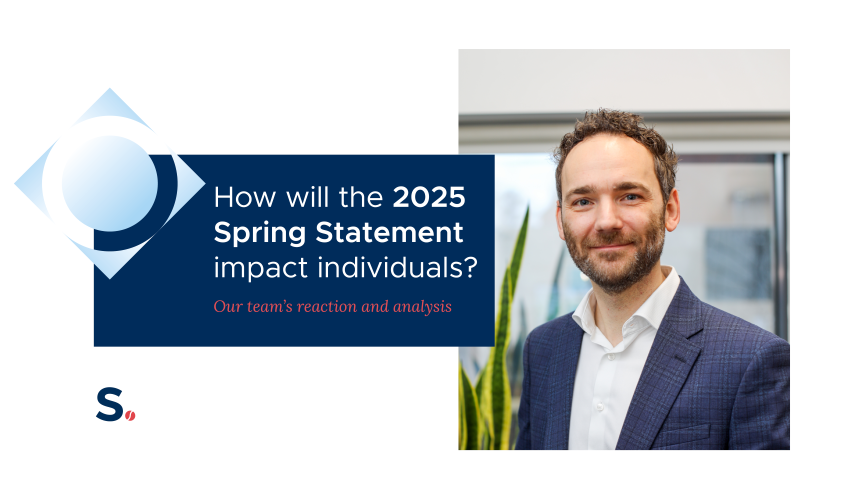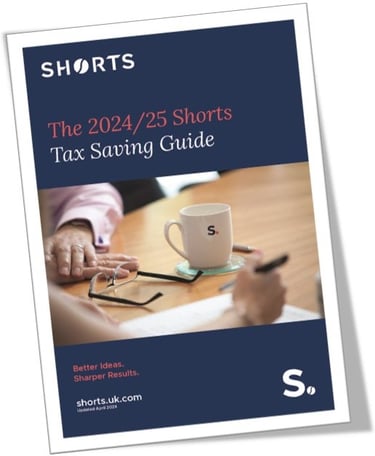
The Chancellor met her commitment that there would be no major tax announcements in the Spring Statement. However there were a number of tax changes announced in the Budget in October, many of which will take effect from April 2025. We have included a recap of these changes below
Personal Tax
Tax bands and rates
The basic rate of tax is 20%. For 2025/26 the band of income taxable at this rate is £37,700 so that the threshold at which the 40% rate applies is £50,270 for those who are entitled to the full personal allowance.
The basic rate band is frozen at £37,700 until April 2028. The NICs Upper Earnings Limit and Upper Profits Limit will remain aligned to the higher rate threshold at £50,270 for these tax years as well. The government has suggested that, from April 2028, these limits will then be uprated in line with inflation.
For 2025/26 the point at which individuals pay the additional rate of 45% is £125,140.
The additional rate for non-savings and non-dividend income will apply to taxpayers in England, Wales and Northern Ireland. The additional rate for savings and dividend income will apply to the whole of the UK.
There are no changes to the taxation of savings and dividend income for 2025/26.
Scottish residents
The tax on income (other than savings and dividend income) is different for taxpayers who are resident in Scotland from that paid by taxpayers resident elsewhere in the UK. The Scottish Income Tax rates and bands apply to income such as employment income, self-employed trade profits and property income.
In 2024/25 a new 45% rate was introduced, making six Income Tax rates which range between 19% and 48%. The rates and bands for 2025/26 for taxable income are as follows:
|
£ |
% |
|
0 - 2,827 |
19 |
|
2,828 - 14,921 |
20 |
|
14,922 - 31,092 |
21 |
|
31,093 - 62,430 |
42 |
|
62,431 - 125,140 |
45 |
|
Over 125,140 |
48 |
Scottish taxpayers are entitled to the same personal allowance as individuals in the rest of the UK.
Welsh residents
Since April 2019 the Welsh Government has had the right to vary the rates of Income Tax payable by Welsh taxpayers (other than tax on savings and dividend income). For 2025/26 the tax payable by Welsh taxpayers is the same as that payable by English and Northern Irish taxpayers.
The personal allowance
The Income Tax personal allowance is fixed at the current level of £12,570 until April 2028. The government has suggested that, from April 2028, it will then be uprated in line with inflation.
There is a reduction in the personal allowance for those with ‘adjusted net income’ over £100,000. The reduction is £1 for every £2 of income above £100,000. This means that there is no personal allowance where adjusted net income exceeds £125,140.
The government will uprate the married couple’s allowance and blind person’s allowance for 2025/26.
Pension tax limits
For 2025/26:
- The Annual Allowance (AA) is £60,000.
- Individuals who have ‘threshold income’ for a tax year of greater than £200,000 have their AA for that tax year restricted. It is reduced by £1 for every £2 of ‘adjusted income’ over £260,000, to a minimum AA of £10,000.
- The Lump Sum Allowance, which relates to the general maximum that may be able to be taken as a tax-free lump sum, is £268,275.
- The Lump Sum and Death Benefit Allowance, which relates to the general maximum that may be able to be taken as a tax-free lump sum in certain circumstances, is £1,073,100.
Non-UK domiciled individuals
Significant changes are made to the tax regime relating to non-UK domiciled individuals. Broadly, from 6 April 2025, changes will be made to replace the remittance basis of taxation, which is based on domicile status, with a new tax regime based on residence. The new regime will provide 100% relief on foreign income and gains for new arrivals to the UK in their first four years of tax residence, provided they have not been UK tax resident in any of the ten consecutive years prior to their arrival.
The protection from tax on foreign income and gains arising within settlor-interested trust structures will no longer be available for non-domiciled and deemed domiciled individuals who do not qualify for the four-year foreign income and gains regime.
Transitionally, for Capital Gains Tax purposes, current and past remittance basis users will be able to rebase foreign assets they held on 5 April 2017 to their value at that date when they dispose of them.
Any foreign income and gains that arose on or before 5 April 2025, while an individual was taxed under the remittance basis, will continue to be taxed when remitted to the UK under the current rules. This includes remittances by those who are eligible for the new four-year foreign income and gains regime.
A Temporary Repatriation Facility (the Facility) will be available for individuals who have previously claimed the remittance basis. They will be able to designate and remit, at a reduced rate, foreign income and gains that arose prior to the changes. The Facility will be available for a limited period of three tax years, beginning in 2025/26. The Facility rate will be 12% for the first two years and 15% in the final tax year of operation.
The current domicile-based system of Inheritance Tax will be replaced with a new residence-based system, which will affect the scope of non-UK property brought into UK Inheritance Tax for individuals and trusts.
Overseas Workday Relief will be extended to four years to align with the new four-year foreign income and gains regime and will be subject to a financial limit on the amount of relief that can be claimed, namely the lower of £300,000 or 30% of an individual’s total employment income.
Comment |
|
This is a significant change in the taxation system. Even if individuals have not considered or used the remittance basis in the past, it may well be that some are still affected. Making the regime residence based may mean that long term resident, non-domiciled individuals will now find that Inheritance Tax is due on their worldwide, rather than UK, assets. |
National Insurance contributions
Employees and employers
The government announced that it will increase the employer rate from 13.8% to 15% from 6 April 2025. The main rate of Class 1 employee National Insurance contributions (NICs) is 8%.
The Secondary Threshold is the point at which employers become liable to pay NICs on an individual employee’s earnings and is currently set at £9,100 a year. The government will reduce the Secondary Threshold to £5,000 a year from 6 April 2025 until 6 April 2028 and then increase it by Consumer Price Index (CPI) thereafter.
The Employment Allowance currently allows businesses with employer NICs bills of £100,000 or less in the previous tax year to deduct £5,000 from their employer NICs bill. From 6 April 2025 the government will increase the Employment Allowance from £5,000 to £10,500 and remove the £100,000 threshold for eligibility, expanding this to all eligible employers with employer NIC bills.
Comment |
|
For some businesses, this will create a large additional NICs cost from April 2025. It remains to be seen what the implications are for both the economy and the job market. |
The self-employed and NICs
From 6 April 2025 the rates of Class 4 self-employed NICs are 6% and 2%. For Class 2 NICs from 6 April 2025:
- Self-employed people with profits of £6,845 and above get access to contributory benefits, including the State Pension, through a National Insurance credit, without paying Class 2 NICs.
- Those with profits under £6,845 and others who pay Class 2 NICs voluntarily to get access to contributory benefits including the State Pension will continue to be able to do so.
For those paying voluntarily, the government will also increase Class 2 and Class 3 NICs to £3.50 and £17.75 respectively for 2025/26.
Employment
National Living Wage and National Minimum Wage
The government has announced increased rates of the National Living Wage (NLW) and National Minimum Wage (NMW) which will come into force from 1 April 2025. The rates which will apply are as follows:
|
|
NLW |
18-20 |
16-17 |
Apprentices |
|
From 1 April 2025 |
£12.21 |
£10.00 |
£7.55 |
£7.55 |
The apprenticeship rate applies to apprentices under 19 or 19 and over in the first year of apprenticeship. The NLW applies to those aged 21 and over.
Comment |
|
‘Over time, the government intends to create a single adult wage rate… from April 2025, the National Minimum Wage for 18-20 year olds will be £10.00 per hour, an increase of 16.3%, the largest ever increase in both cash and percentage terms. This means a boost to annual earnings of over £2,500 for nearly 200,000 young people across the UK.’ |
Taxable benefits for company cars
The rates of tax for company cars are amended for 2025/26:
- The charge for zero emission cars rises from 2% to 3%.
- The charge for other cars increases by 1%.
- The maximum benefit of 37% remains.
The government has confirmed increases to the benefit in kind rates for company cars for tax years up to and including 2029/30.
Car fuel benefit charge
The car fuel benefit charge is £28,200 from 6 April 2025.
Company vans
The van benefit charge is £4,020 and the van fuel benefit charge is £769 from 6 April 2025.
Treatment of double cab pick-up vehicles
The government will treat double cab pick-up vehicles (DCPUs) with a payload of one tonne or more as cars for certain tax purposes.
From 1 April 2025 for Corporation Tax, and 6 April 2025 for Income Tax, DCPUs will be treated as cars for the purposes of capital allowances, benefits in kind and some deductions from business profits.
The existing capital allowances treatment will apply to those who purchase DCPUs before April 2025. Transitional benefit in kind arrangements will apply for employers that have purchased, leased, or ordered a DCPU before 6 April 2025. They will be able to use the previous treatment, until the earlier of disposal, lease expiry, or 5 April 2029.
Capital Gains Tax
Capital Gains Tax rates
The Capital Gains Tax rates increased for disposals, other than of residential property and carried interest, made on or after 30 October 2024. The basic rate of 10% increased to 18% and the 20% rate increased to 24%. No changes were made to the rates applying to the disposal of residential properties of 18% and 24%.
The rate applying to trustees and personal representatives increased from 20% to 24% from the same date.
Comment |
|
The changes in the main rates of Capital Gains Tax brings them in line with those paid on disposal of residential property. This means that there will be no need going forward to differentiate between the types of property being disposed of. |
Capital Gains Tax annual exemption
The annual exempt amount will remain at £3,000 for 2025/26.
Business Asset Disposal Relief and Investors’ Relief
The rate applying for individuals claiming Business Asset Disposal Relief and Investors’ Relief will increase from 10% to 14% for disposals made on or after 6 April 2025. The rate will increase again to 18% for disposals made on or after 6 April 2026.
In addition, the lifetime limit for Investors’ Relief reduced from £10 million to £1 million for qualifying disposals made on or after 30 October 2024. This limit takes into account any prior qualifying gains where the relief was claimed.
Inheritance Tax
Inheritance Tax nil rate bands
The nil rate band has been frozen at £325,000 since 2009 and this will continue to be frozen up to 5 April 2030. An additional nil rate band, called the ‘residence nil rate band’ is also frozen at the current £175,000 level, as is the residence nil rate band taper starting at £2 million. These are also frozen until 5 April 2030.
Unused pension funds and death benefits
The government will bring unused pension funds and death benefits payable from a pension into a person’s estate for Inheritance Tax purposes from 6 April 2027.
Agricultural Property Relief and Business Property Relief
From 6 April 2026, agricultural and business property will continue to benefit from the 100% Inheritance Tax relief up to a limit of £1 million. The limit is a combined limit for both agricultural and business property. Property in excess of the limit will benefit from a 50% relief, as will, in all circumstances, quoted shares designated as ‘not listed’ on the markets of recognised stock exchanges, such as AIM.
Read more about how the Spring Statement will affect Businesses
Read more about how the Spring Statement in overview

Craig Walker
I am Chartered Tax Adviser and am a full member of the Society of Trust & Estate Practitioners (STEP). As a Tax Partner, I advise clients on all aspects of tax but I have a particular focus on private client matters.
View my articlesTags: Private Client, Business Taxes




